Jupiter’s North Pole Unlike Anything Encountered In Solar System
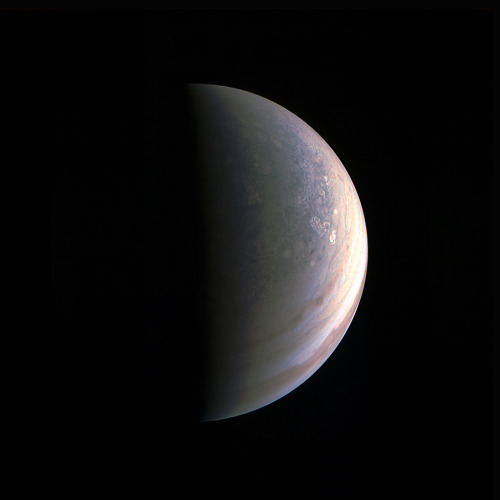
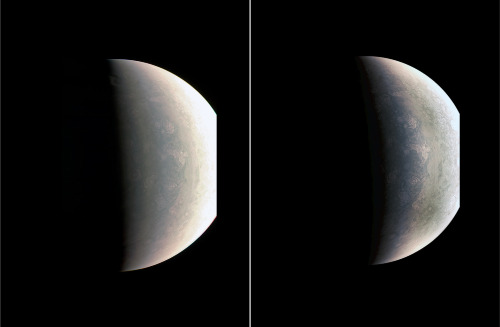
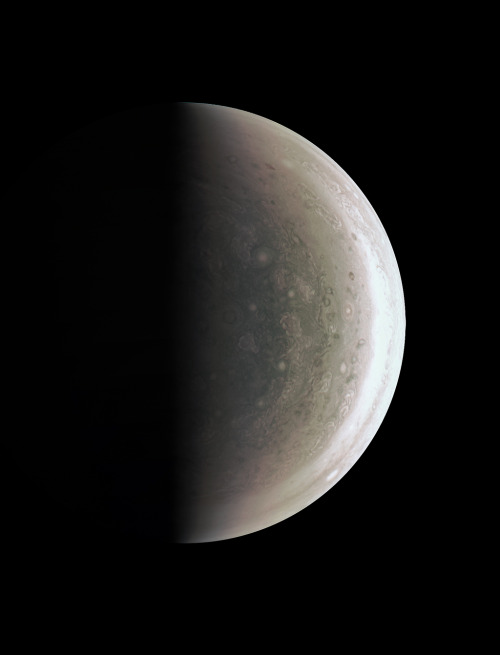
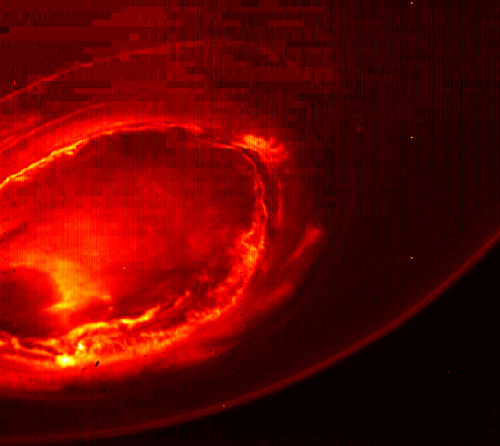
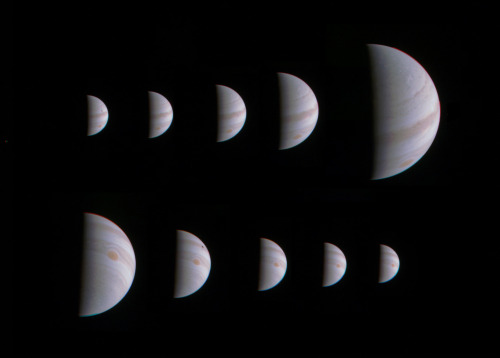
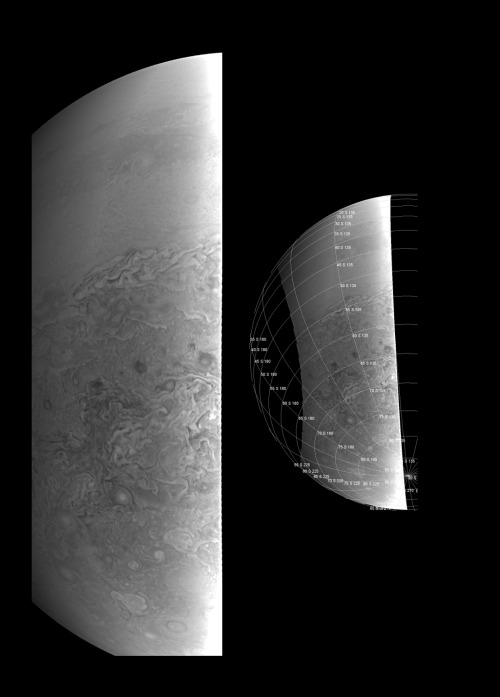
Jupiter’s North Pole Unlike Anything Encountered in Solar System
NASA’s Juno spacecraft has sent back the first-ever images of Jupiter’s north pole, taken during the spacecraft’s first flyby of the planet with its instruments switched on. The images show storm systems and weather activity unlike anything previously seen on any of our solar system’s gas-giant planets.
Juno successfully executed the first of 36 orbital flybys on Aug. 27 when the spacecraft came about 2,500 miles (4,200 kilometers) above Jupiter’s swirling clouds. The download of six megabytes of data collected during the six-hour transit, from above Jupiter’s north pole to below its south pole, took one-and-a-half days. While analysis of this first data collection is ongoing, some unique discoveries have already made themselves visible.
“First glimpse of Jupiter’s north pole, and it looks like nothing we have seen or imagined before,” said Scott Bolton, principal investigator of Juno from the Southwest Research Institute in San Antonio. “It’s bluer in color up there than other parts of the planet, and there are a lot of storms. There is no sign of the latitudinal bands or zone and belts that we are used to – this image is hardly recognizable as Jupiter. We’re seeing signs that the clouds have shadows, possibly indicating that the clouds are at a higher altitude than other features.”
One of the most notable findings of these first-ever pictures of Jupiter’s north and south poles is something that the JunoCam imager did not see.
“Saturn has a hexagon at the north pole,” said Bolton. “There is nothing on Jupiter that anywhere near resembles that. The largest planet in our solar system is truly unique. We have 36 more flybys to study just how unique it really is.”
Along with JunoCam snapping pictures during the flyby, all eight of Juno’s science instruments were energized and collecting data. The Jovian Infrared Auroral Mapper (JI-RAM), supplied by the Italian Space Agency, acquired some remarkable images of Jupiter at its north and south polar regions in infrared wavelengths.
“JIRAM is getting under Jupiter’s skin, giving us our first infrared close-ups of the planet,” said Alberto Adriani, JIRAM co-investigator from Istituto di Astrofisica e Planetologia Spaziali, Rome. “These first infrared views of Jupiter’s north and south poles are revealing warm and hot spots that have never been seen before. And while we knew that the first ever infrared views of Jupiter’s south pole could reveal the planet’s southern aurora, we were amazed to see it for the first time. No other instruments, both from Earth or space, have been able to see the southern aurora. Now, with JIRAM, we see that it appears to be very bright and well structured. The high level of detail in the images will tell us more about the aurora’s morphology and dynamics.”
Among the more unique data sets collected by Juno during its first scientific sweep by Jupiter was that acquired by the mission’s Radio/Plasma Wave Experiment (Waves), which recorded ghostly- sounding transmissions emanating from above the planet. These radio emissions from Jupiter have been known about since the 1950s but had never been analyzed from such a close vantage point.
“Jupiter is talking to us in a way only gas-giant worlds can,” said Bill Kurth, co-investigator for the Waves instrument from the University of Iowa, Iowa City. “Waves detected the signature emissions of the energetic particles that generate the massive auroras which encircle Jupiter’s north pole. These emissions are the strongest in the solar system. Now we are going to try to figure out where the electrons come from that are generating them.”
The Juno spacecraft launched on Aug. 5, 2011, from Cape Canaveral, Florida and arrived at Jupiter on July 4, 2016. JPL manages the Juno mission for the principal investigator, Scott Bolton, of Southwest Research Institute in San Antonio. Juno is part of NASA’s New Frontiers Program, which is managed at NASA’s Marshall Space Flight Center in Huntsville, Alabama, for NASA’s Science Mission Directorate. Lockheed Martin Space Systems, Denver, built the spacecraft. Caltech in Pasadena, California, manages JPL for NASA.
IMAGE 1….As NASA’s Juno spacecraft closed in on Jupiter for its Aug. 27, 2016 pass, its view grew sharper and fine details in the north polar region became increasingly visible. The JunoCam instrument obtained this view on August 27, about two hours before closest approach, when the spacecraft was 120,000 miles (195,000 kilometers) away from the giant planet (i.e., for Jupiter’s center). Unlike the equatorial region’s familiar structure of belts and zones, the poles are mottled with rotating storms of various sizes, similar to giant versions of terrestrial hurricanes. Jupiter’s poles have not been seen from this perspective since the Pioneer 11 spacecraft flew by the planet in 1974.
IMAGE 2….Storm systems and weather activity unlike anything encountered in the solar system are on view in these color images of Jupiter’s north polar region from NASA’s Juno spacecraft. Two versions of the image have been contrast-enhanced differently to bring out detail near the dark terminator and near the bright limb. The JunoCam instrument took the images to create this color view on August 27, when the spacecraft was about 48,000 miles (78,000 kilometers) above the polar cloud tops. A wavy boundary is visible halfway between the grayish region at left (closer to the pole and the nightside shadow) and the lighter-colored area on the right. The wavy appearance of the boundary represents a Rossby wave – a north-south meandering of a predominantly east-west flow in an atmospheric jet. This may be caused by a difference in temperature between air to the north and south of this boundary, as is often the case with such waves in Earth’s atmosphere. The polar region is filled with a variety of discrete atmospheric features. Some of these are ovals, but the larger and brighter features have a “pinwheel” shape reminiscent of the shape of terrestrial hurricanes. Tracking the motion and evolution of these features across multiple orbits will provide clues about the dynamics of the Jovian atmosphere. This image also provides the first example of cloud shadowing on Jupiter: near the top of the image, a high cloud feature is seen past the normal boundary between day and night, illuminated above the cloud deck below. While subtle color differences are visible in the image, some of these are likely the result of scattered light within the JunoCam optics. Work is ongoing to characterize these effects.
IMAGE 3….This image from NASA’s Juno spacecraft provides a never-before-seen perspective on Jupiter’s south pole. The JunoCam instrument acquired the view on August 27, 2016, when the spacecraft was about 58,700 miles (94,500 kilometers) above the polar region. At this point, the spacecraft was about an hour past its closest approach, and fine detail in the south polar region is clearly resolved. Unlike the equatorial region’s familiar structure of belts and zones, the poles are mottled by clockwise and counterclockwise rotating storms of various sizes, similar to giant versions of terrestrial hurricanes. The south pole has never been seen from this viewpoint, although the Cassini spacecraft was able to observe most of the polar region at highly oblique angles as it flew past Jupiter on its way to Saturn in 2000
IMAGE 4….This infrared image gives an unprecedented view of the southern aurora of Jupiter, as captured by NASA’s Juno spacecraft on August 27, 2016. The planet’s southern aurora can hardly be seen from Earth due to our home planet’s position in respect to Jupiter’s south pole. Juno’s unique polar orbit provides the first opportunity to observe this region of the gas-giant planet in detail. Juno’s Jovian Infrared Auroral Mapper (JIRAM) camera acquired the view at wavelengths ranging from 3.3 to 3.6 microns – the wavelengths of light emitted by excited hydrogen ions in the polar regions. The view is a mosaic of three images taken just minutes apart from each other, about four hours after the perijove pass while the spacecraft was moving away from Jupiter.
IMAGE 5….This montage of 10 JunoCam images shows Jupiter growing and shrinking in apparent size before and after NASA’s Juno spacecraft made its closest approach on August 27, 2016, at 12:50 UTC. The images are spaced about 10 hours apart, one Jupiter day, so the Great Red Spot is always in roughly the same place. The small black spots visible on the planet in some of the images are shadows of the large Galilean moons. The images in the top row were taken during the inbound leg of the orbit, beginning on August 25 at 13:15 UTC when Juno was 1.4 million miles (2.3 million kilometers) away from Jupiter, and continuing to August 27 at 04:45 UTC when the spacecraft was 430,000 miles (700,000 kilometers) away. The images in the bottom row were obtained during the outbound leg of the orbit. They begin on August 28 at 00:45 UTC when Juno was 750,000 miles (920,000 kilometers) away and continue to August 29 at 16:45 UTC when the spacecraft was 1.6 million miles (2.5 million kilometers) away.
IMAGE 6….This image provides a close-up view of Jupiter’s southern hemisphere, as seen by NASA’s Juno spacecraft on August 27, 2016. The JunoCam instrument captured this image with its red spectral filter when the spacecraft was about 23,600 miles (38,000 kilometers) above the cloud tops. The image covers an area from close to the south pole to 20 degrees south of the equator, centered on a longitude at about 140 degrees west. The transition between the banded structures near the equator and the more chaotic polar region (south of about 65 degrees south latitude) can be clearly seen. The smaller version at right of this image shows the same view with a latitude/longitude grid overlaid. This image has been processed to remove shading effects near the terminator – the dividing line between day and night – caused by Juno’s orbit.
More Posts from Littlecadet-biguniverse and Others

The Sunflower Galaxy

Galaxy Ngc474

NGC 2736: The Pencil Nebula
js

Milky Way from Lake Cuyamaca js
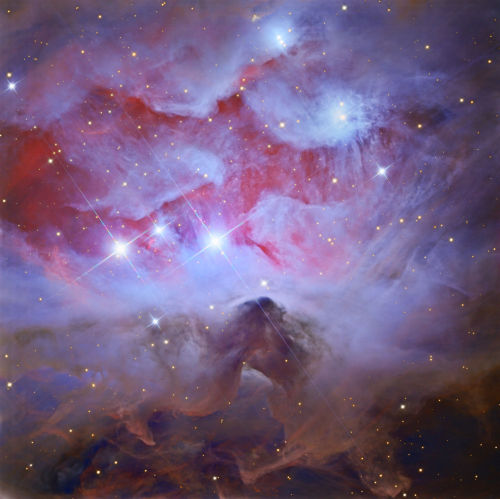
Running Man Nebula
js
Hubble Peers into the Storm
NASA - Hubble Space Telescope patch. Sept. 9, 2016
This shot from the NASA/ESA Hubble Space Telescope shows a maelstrom of glowing gas and dark dust within one of the Milky Way’s satellite galaxies, the Large Magellanic Cloud (LMC). This stormy scene shows a stellar nursery known as N159, an HII region over 150 light-years across. N159 contains many hot young stars. These stars are emitting intense ultraviolet light, which causes nearby hydrogen gas to glow, and torrential stellar winds, which are carving out ridges, arcs, and filaments from the surrounding material. At the heart of this cosmic cloud lies the Papillon Nebula, a butterfly-shaped region of nebulosity. This small, dense object is classified as a High-Excitation Blob, and is thought to be tightly linked to the early stages of massive star formation.
Hubble orbiting Earth
N159 is located over 160,000 light-years away. It resides just south of the Tarantula Nebula (heic1402), another massive star-forming complex within the LMC. This image comes from Hubble’s Advanced Camera for Surveys. The region was previously imaged by Hubble’s Wide Field Planetary Camera 2, which also resolved the Papillon Nebula for the first time. Related links: heic1402: https://www.spacetelescope.org/news/heic1402/ Hubble’s Wide Field Planetary Camera 2: https://www.spacetelescope.org/about/general/instruments/wfpc2/ For more information about the Hubble Space Telescope, visit: http://hubblesite.org/ http://www.nasa.gov/hubble https://www.spacetelescope.org/ Image, Video, Text, Credits: ESA/Hubble & NASA/Text credit: European Space Agency/NASA/Karl Hille. Greetings, Orbiter.ch Full article

Saturn in three bands of infrared light.
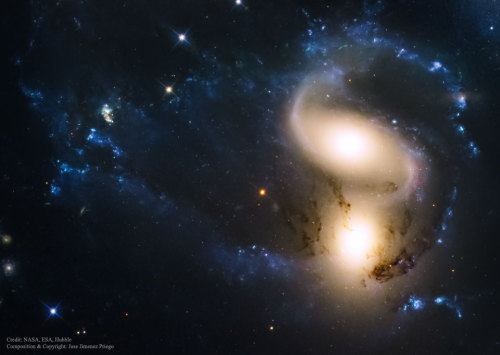
Colliding Galaxies NGC 7318, part of Stephan’s Quintet
Bubble Nebula by Hubble Heritage Via Flickr: For the 26th birthday of NASA’s Hubble Space Telescope, astronomers are highlighting a Hubble image of an enormous bubble being blown into space by a super-hot, massive star. The Hubble image of the Bubble Nebula, or NGC 7635, was chosen to mark the 26th anniversary of the launch of Hubble into Earth orbit by the STS-31 space shuttle crew on April 24, 1990. The Bubble Nebula is 7 light-years across — about one-and-a-half times the distance from our sun to its nearest stellar neighbor, Alpha Centauri. The Bubble Nebula was discovered in 1787 by William Herschel, a prominent British astronomer. It is being formed by a prototypical Wolf-Rayet star, an extremely bright, massive, and short-lived star that has lost most of its outer hydrogen and is now fusing helium into heavier elements. The star is about 4 million years old, and in 10 million to 20 million years, it will likely detonate as a supernova.
Credit: NASA, ESA, and the Hubble Heritage Team (STScI/AURA) heritage.stsci.edu/2016/13/ hubbledev.stsci.edu/newscenter/archive/releases/2016/13/
-
 deadassdiaspore reblogged this · 4 years ago
deadassdiaspore reblogged this · 4 years ago -
 sonicsoundscapes liked this · 6 years ago
sonicsoundscapes liked this · 6 years ago -
 a-splash-of-indigo liked this · 6 years ago
a-splash-of-indigo liked this · 6 years ago -
 king-sir-44 reblogged this · 7 years ago
king-sir-44 reblogged this · 7 years ago -
 king-sir-44 liked this · 7 years ago
king-sir-44 liked this · 7 years ago -
 oruamatrop-blog liked this · 8 years ago
oruamatrop-blog liked this · 8 years ago -
 palaxies reblogged this · 8 years ago
palaxies reblogged this · 8 years ago -
 brunorichardsonmachado-blog liked this · 8 years ago
brunorichardsonmachado-blog liked this · 8 years ago -
 coldcemeteries liked this · 8 years ago
coldcemeteries liked this · 8 years ago -
 fomaelhaut reblogged this · 8 years ago
fomaelhaut reblogged this · 8 years ago -
 tthomusic liked this · 8 years ago
tthomusic liked this · 8 years ago -
 petros2020-blog liked this · 8 years ago
petros2020-blog liked this · 8 years ago -
 completely-overjoyed-blog1 liked this · 8 years ago
completely-overjoyed-blog1 liked this · 8 years ago -
 lauregui-mcgrath liked this · 8 years ago
lauregui-mcgrath liked this · 8 years ago -
 lady--nebula reblogged this · 8 years ago
lady--nebula reblogged this · 8 years ago -
 happy-thoughts--and--pixie-dust liked this · 8 years ago
happy-thoughts--and--pixie-dust liked this · 8 years ago -
 midna2123 reblogged this · 8 years ago
midna2123 reblogged this · 8 years ago -
 midna2123 liked this · 8 years ago
midna2123 liked this · 8 years ago -
 depress-ed-bitxh liked this · 8 years ago
depress-ed-bitxh liked this · 8 years ago -
 dpeman liked this · 8 years ago
dpeman liked this · 8 years ago -
 aesthetically-pleasing-worldx liked this · 8 years ago
aesthetically-pleasing-worldx liked this · 8 years ago -
 alostandlonelygirl liked this · 8 years ago
alostandlonelygirl liked this · 8 years ago -
 heyitsdelaila liked this · 8 years ago
heyitsdelaila liked this · 8 years ago -
 ramon-balaguer liked this · 8 years ago
ramon-balaguer liked this · 8 years ago -
 stew31415 liked this · 8 years ago
stew31415 liked this · 8 years ago -
 netflixandchillforone liked this · 8 years ago
netflixandchillforone liked this · 8 years ago -
 bugzymrmalone-blog liked this · 8 years ago
bugzymrmalone-blog liked this · 8 years ago -
 duranwang liked this · 8 years ago
duranwang liked this · 8 years ago -
 nightvalescommunityobelisk liked this · 8 years ago
nightvalescommunityobelisk liked this · 8 years ago -
 ptvtonyp liked this · 8 years ago
ptvtonyp liked this · 8 years ago -
 girlsoverdxse-blog liked this · 8 years ago
girlsoverdxse-blog liked this · 8 years ago -
 somethinglite liked this · 8 years ago
somethinglite liked this · 8 years ago -
 meritbridal-blog liked this · 8 years ago
meritbridal-blog liked this · 8 years ago -
 thatchloe liked this · 8 years ago
thatchloe liked this · 8 years ago -
 photographyblog11 liked this · 8 years ago
photographyblog11 liked this · 8 years ago
GREETINGS FROM EARTH! Welcome to my space blog! Let's explore the stars together!!!
144 posts
